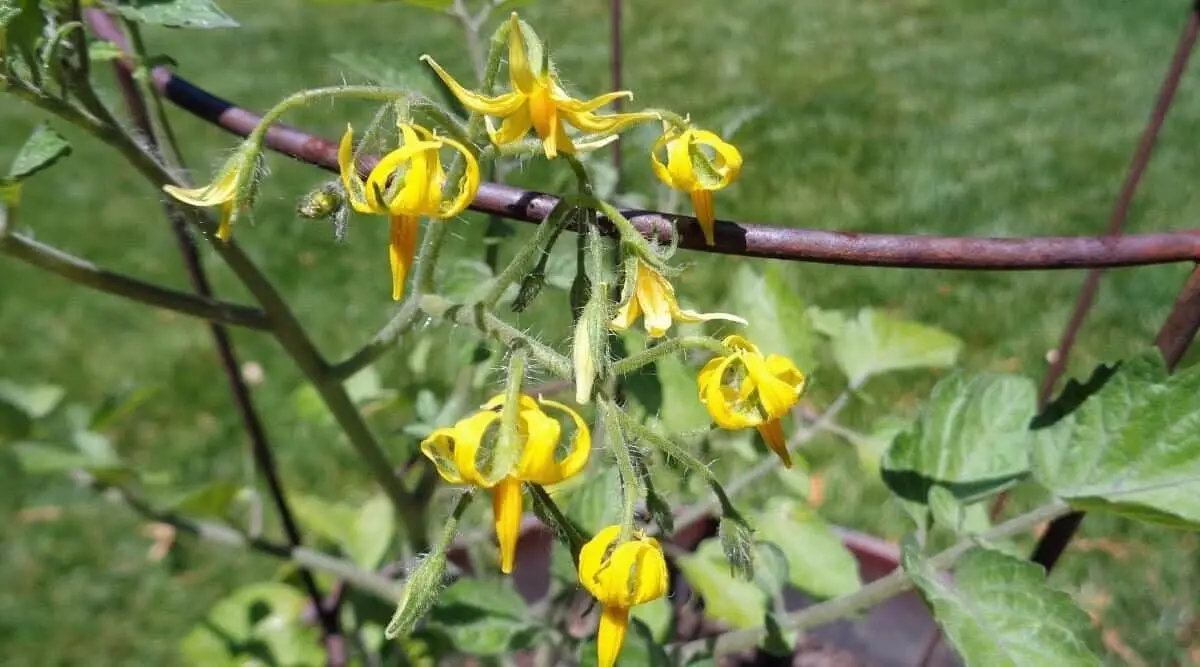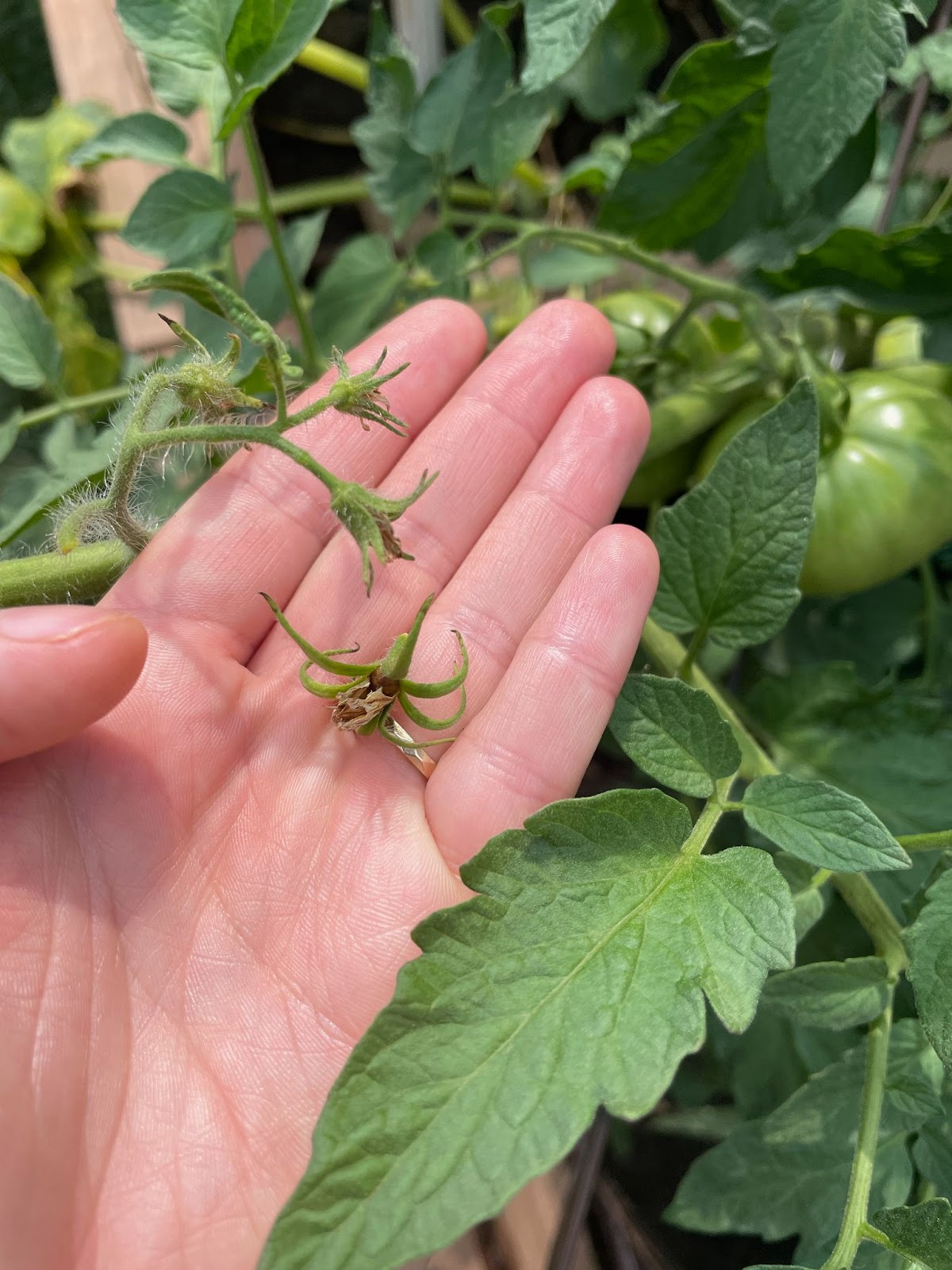You have given enough care to your tomato plants throughout spring. But they haven’t started to produce any actual tomatoes yet. Anyone who gardens knows how frustrating this can be.
One reason why your tomato plants are not fruiting can be poor pollination. Along with that lack of fertility, insufficient light and water etc. Providing the plants sufficient sunlight and water can be a fix. Also, you can consider hand pollination or importing pollinators to solve the issue.
Well, that is not all. In this article, I have delved deeper into the most typical causes of your tomato plants not producing fruit. Also, I have provided the best solutions to use. Keep reading!
Reasons and Solutions for Still No Tomatoes
Here you will find all the reasons why your tomato plants are not bearing fruits. Here I have provided a snapshot of all the reasons and solutions. Have a glance.
| Reasons | Solutions |
| Insufficient light | Put plants in direct sunlight |
| Insufficient Water | Provide sufficient water |
| Poor pollination | Hand pollination
Import pollinators |
| Lack of fertility | Fertilize with potassium and phosphorus |
| Temperature | Cover the plants using frost cloth or a low tent |
| Too much nitrogen | Provide ideal amount as instructed in container |
Also, if you find other problems with your tomato plant like tomatoes with pointed ends, take immediate action. Now, let’s dive into the details for no tomato issue.
Reason 1: Insufficient light
One of the primary causes of non-fruiting is inadequate lighting.
Tomato plants may not give any fruit if there is insufficient sunlight. This is because the tomatoes are unable to receive enough photosynthetic energy to support their growth.
The plant needs water, sunlight, and minerals for photosynthesis in order to produce the carbohydrates it requires for survival. To generate fruit, tomato plants require a minimum of six to eight hours of direct sunlight every day.

Otherwise you’ll get lots of foliage—albeit weak or lanky growth—and some blooms, but few to no tomatoes. The sun provides those plants with the sufficient energy they need to fruit.
Solution
You should relocate your tomato plants if they aren’t getting enough light. If your tomatoes are growing in containers, place them in direct sunshine.
If trees or bushes are shadowing your yard, think about cutting a few branches to let in more light.
If you are planting them in the yard, simply plant tomatoes in that area of the garden which has the most sunlight.
Reason 2: Too Little Water
Given that the tomatoes are mostly (90%) water, it shouldn’t come as a surprise that watering issues can significantly lower your tomato output. Your plants need a lot of water to sustain the transition from flowering to fruiting. Drought-affected plants may seem yellow, droopy, or withered.
On the other hand, overwatering tomatoes can result in root rot, which completely halts plant growth. The tomato roots lose their ability to absorb nutrients and water, which prevents them from producing blooms and fruits as they start to suffocate and shrivel.
Yellowing or browning leaves, as well as blisters or lumps on the lower foliage, are typical symptoms of overwatered tomatoes.
Solution
Tomatoes require approx 1 inch of water per week. To make sure your tomatoes are receiving enough moisture, check on them every few days. By inserting a dry finger into the soil close to the plant’s base at a depth of about 6 inches, you can perform the “finger test”.
- The dirt is far too dry if the finger comes out clean.
- The water level is satisfactory if you emerge from it with some dirt still on your skin.
- If it turns out to be overly moist, you might have overwatered.
Reason 3: Poor Pollination
Like many other garden plants, tomatoes depend on the breeze or bees to pollinate their flowers. If you see many yellow flowers on those plants, but they never seem to turn into fruit, you definitely don’t have enough pollinators.

Bees, butterflies, and other kinds of insects should constantly buzz throughout a healthy garden ecosystem, including both honeybees of native bees. In a lack of both food as well as habitat of these pollinators, your tomato blossoms may remain dormant as they wait for the pollen to be spread.
Alternately, harsh weather conditions or high humidity may limit the activity of pollinators in your garden. Refer to the weather section below if you typically have a lot of bees but the recent weather has been exceptionally cold (under 40°F) or exceptionally hot (over 90°F).
You may also be deficient in wind that can waft pollen from bloom to flower if the garden is very protected or if your tomato plants are being produced in a greenhouse.
Solution
To solve this issue, you can consider hand pollination or importing pollinators.
Hand Pollination:
Use an old toothbrush or a pencil to gently shake or tap the inside of tomato blooms. Do it on a sunny and warm day. You might also use a paintbrush or your finger. This induces a buzzing bee’s vibrations. Since tomato blossoms self-pollinate, they have both male as well as female reproductive organs within a single blossom. The tapping will encourage the plant to immediately deposit pollen onto the flower’s stigma. Flowers should start to wilt as fruits form after doing this daily for a couple of days.
Importing Pollinators:
To assist in pollinating your tomatoes, you can buy bumble bees or even mason bees from garden supply stores or sources of beneficial insects. Although releasing these insects can provide a short-term solution, keep in mind that they will need access to adjacent floral supplies in order to remain in your garden.
Reason 4: Lack of Fertility
Tomatoes won’t have the amount of energy they require to produce fruit if they aren’t given sufficient nutrients. Potassium and phosphorus are especially important during the reproductive (fruiting) phase. While phosphorus boosts fruit harvests and ripening, potassium encourages the development of flowers.
Solution
Avoid feeding nitrogen to plants as they begin to bloom, and instead begin fertilizing with potassium and phosphorus. I prefer to side dress tomato plants with liquid or granulated kelp fertilizer twice a week by the plant’s base.
Reason 5: Temperature
Tomatoes are a warm-weather crop that suffers greatly in the winter. Lower than 50°F temperatures have the potential to drastically slow tomato growth or perhaps destroy the blooms.
In places that have high temperature during the day and low overnight temperatures, flower drop is a particular challenge. There’s no fruit if there are no flowers! Temperatures from 60°F and 85°F are ideal for tomatoes to bear fruit.
When tomatoes are in their reproductive stage, heat might also be a problem. When they are under the effects of heat stress, they find it challenging to cling onto flowers. They may voluntarily drop their blossoms or cease flower production during an intense heat wave. If they are experiencing drought stress, this is very likely.
It can be too chilly and damp or too hot and dry if you have a lot of large blossoms but no tomatoes. Blossom drop occurs as a result, which will obviously make it much harder for plants to generate fruit.
Solution
Use frost cloth or a low tent to cover your tomatoes if a cold front is anticipated. Look for southern heat-tolerant types that is going to set fruit in the blazing summer in areas that are extremely hot or humid.
Reason 6: Too Much Nitrogen
Your tomato plants may not be fertile if they appear large and lush but aren’t bearing fruit.
A large amount of foliage but no tomatoes is a classic indicator of nitrogen overload. Also, yellowing foliage and stunted development can suggest a nitrogen deficit.
This may also occur if the soil is very alkaline, which would result in an excess of nitrogen availability.
Although nitrogen is obviously necessary for tomato plants to live, an excess can inhibit fruiting by causing an overgrowth of leaves. Without numerous blossoms, plants may appear excessively tall, leafy, and green. The plant may focus the majority of its energy on growing new leaves rather than on fruiting as a result of the imbalance in the fertilizer.
Solution:
The solution to this tomato fruiting issue is prevention. When planting tomatoes, you should only provide a tiny amount of nitrogen. Because they release slowly and are less likely to result in nitrogen excess, organic fertilizers typically perform better. Avoid using concentrated nitrates, and always follow the directions on the fertilizer container.
If you’ve already overfertilized your tomato plants, you can try deeply watering them to flush out some of the nitrogen or mulching the area surrounding the plants with carbon-rich material to help the soil become more neutral.
Alternatively, if you’re thinking of planting moldy potatoes, don’t. There are several reasons such as rotting issues, disease introduction, etc.
Frequently Asked Questions (FAQs):
Why are tomatoes not growing fast?
The lack of sufficient warmth in the soil is one of the most frequent causes of tomato development being delayed. Contrary to popular belief, plants require warm soil for them to grow quickly. Since tomatoes require a lot of water, they can’t benefit from low temps like other plants may.
How do I know if my tomato plants are healthy?
Healthy tomato plants will have sturdy stems and velvety, medium- to dark-green leaves. If the leaves are yellow or pale, have dark or ragged regions or margins, or have mildew symptoms, it means they are not healthy.
What month is best for tomatoes?
It is typically advised to plant tomatoes in early to mid-May. As warm-season plants, tomatoes cannot withstand frost or extremely cold temperatures. So, plant them when the threat of frost has passed and the soil has the chance to warm up.
Wrapping Up
Hope I have resolved your question of why are there still no tomatoes in tomato plants.
Keep in mind that producing tomatoes takes time and careful attention to detail. It’s common to encounter obstacles along the way. But with the right attention, caring, you’ll soon be enjoying the fruits of your labor directly from your very own tomato plants.
That is all as of now. Have a terrific day!
- Why Are There Still No Tomatoes in My Tomato Plants? Let’s Fix the Issue! - July 13, 2023
- Water Propagation White Stuff on Roots: Everything You Should Know! - July 11, 2023
- String of Dolphins Drying Up: Solved! - July 11, 2023
